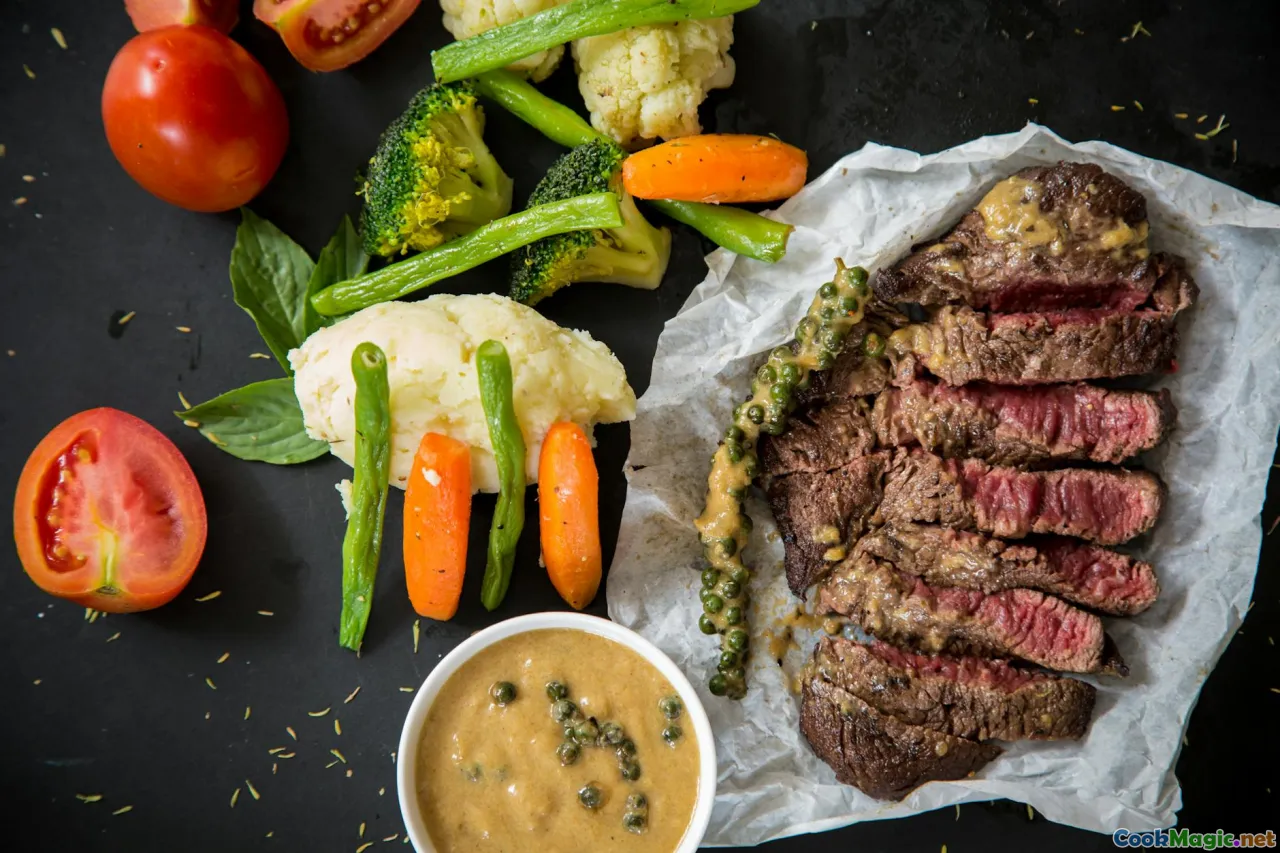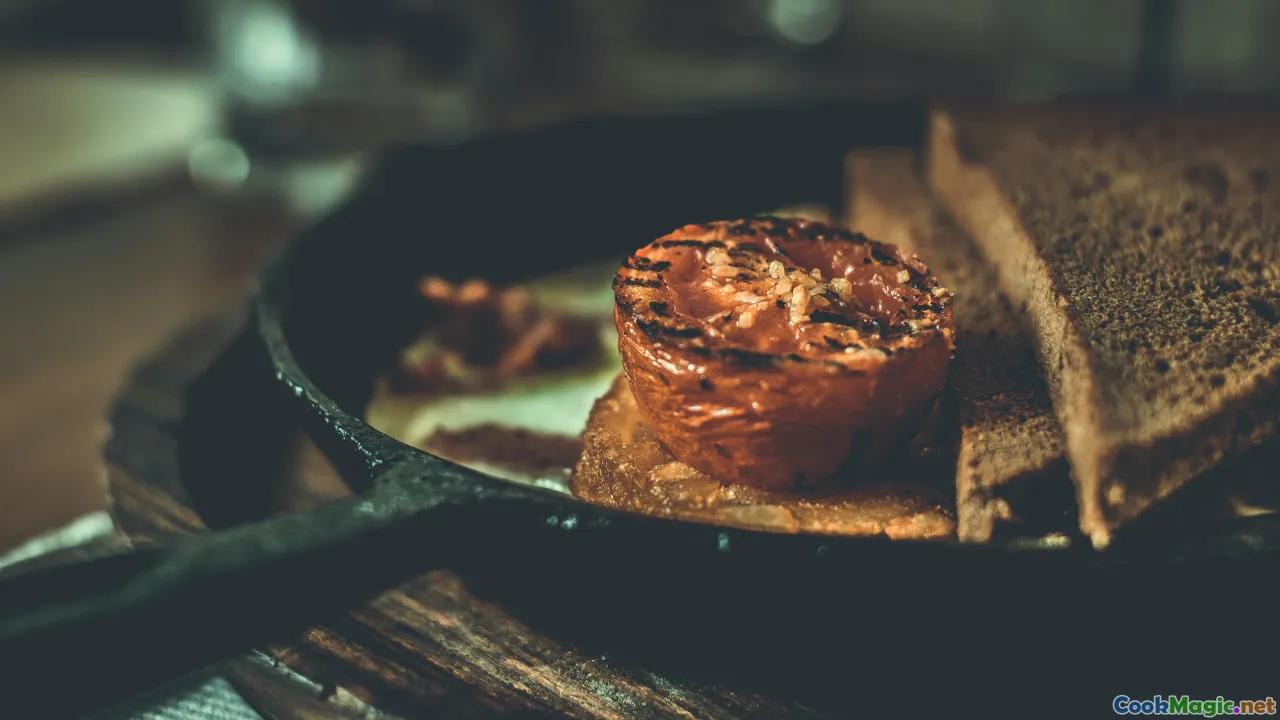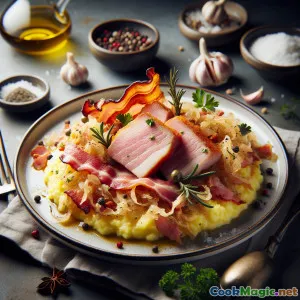
Bánh Trứng Bò và Rau Củ Đậm Đà Vùng Nông Thôn
(Hearty Country Beef & Vegetable Pie)
(0 Đánh giá)0
935
tháng 7 18, 2025
Báo cáo sự cố
Nguyên liệu
-
500 grams Thịt bò vai
(Cắt thành khối vuông 1,5 cm)
-
2 medium Cà rốt
(Gọt vỏ và cắt hạt lựu)
-
1 medium Cần tây
(Gọt vỏ và cắt hạt lựu)
-
1 large Hẹ
(Đã rửa sạch, bổ đôi và thái lát)
-
2 pieces cần tây
(Cắt mỏng)
-
2 small Khoai tây
(Gọt vỏ và cắt hạt lựu)
-
150 grams Nấm nút
(Đã làm sạch và cắt thành tư)
-
3 cloves Tỏi
(Băm)
-
1 tbsp Hương Thì Là Tươi
(Băm nhỏ hoặc 1 muỗng cà phê khô)
-
1 piece Lá nguyệt quế
-
120 ml Rượu vang đỏ
(Khô; thay bằng nước dùng bò nếu cần.)
-
275 ml Nước dùng bò
(Nước dùng rau củ)
-
1 tbsp Nước sốt cà chua
-
1 tsp Muối
(Thêm thêm theo khẩu vị)
-
0.5 tsp Hạt tiêu đen
(Xay mới)
-
2 tbsp Bơ không muối
(Để xào)
-
1 tbsp Dầu ô liu
-
2 sheets Bột bánh quy ngọt bơ
(Hoặc tự làm (khoảng 550 g))
-
1 large Lòng đỏ trứng
(Đánh với 1 thìa cà phê nước (lớp phủ bằng trứng))
-
2 tbsp Ngò tây băm
(Để trang trí)
(Cắt thành khối vuông 1,5 cm)
(Gọt vỏ và cắt hạt lựu)
(Gọt vỏ và cắt hạt lựu)
(Đã rửa sạch, bổ đôi và thái lát)
(Cắt mỏng)
(Gọt vỏ và cắt hạt lựu)
(Đã làm sạch và cắt thành tư)
(Băm)
(Băm nhỏ hoặc 1 muỗng cà phê khô)
(Khô; thay bằng nước dùng bò nếu cần.)
(Nước dùng rau củ)
(Thêm thêm theo khẩu vị)
(Xay mới)
(Để xào)
(Hoặc tự làm (khoảng 550 g))
(Đánh với 1 thìa cà phê nước (lớp phủ bằng trứng))
(Để trang trí)
Dinh dưỡng
- Khẩu phần: 6
- Kích thước khẩu phần: 1 lát (khoảng 260 g)
- Calories: 560 kcal
- Carbohydrates: 41 g
- Protein: 28 g
- Fat: 28 g
- Fiber: 6 g
- Sugar: 7 g
- Sodium: 780 mg
- Cholesterol: 82 mg
- Calcium: 85 mg
- Iron: 4.2 mg
Hướng dẫn
-
1 - Xào thịt bò:
Trong một chảo lớn, làm nóng bơ và dầu ô-liu ở nhiệt độ vừa cao. Ướp các khối thịt bò bằng muối và tiêu; áp chảo thành từng mẻ cho đến khi caramel hóa sâu. Để sang một bên.
-
2 - Xào rau củ:
Ở cùng một chảo, nếu cần thêm bơ. Xào tỏi tây, cần tây, cà rốt, củ cải ngọt, tỏi và nấm cho đến khi mềm và thơm, khoảng 8 phút.
-
3 - Giải khét và ninh nhỏ lửa:
Xào tương cà chua cô đặc và nấu 1 phút. Thêm rượu vang đỏ, gỡ các mảng nâu ở đáy và để nó giảm xuống một nửa. Đưa thịt bò trở lại chảo cùng khoai tây, thì là và lá nguyệt quế.
-
4 - Thêm nước dùng và hầm:
Đổ nước dùng bò vào. Đậy nắp và đun liu riu ở lửa nhỏ trong 30-35 phút cho đến khi thịt bò và rau củ vừa mềm và nước sánh lại. Nêm nếm cho vừa ăn; để nguội hoàn toàn.
-
5 - Chuẩn bị vỏ bánh:
Làm nóng lò ở 200°C (390°F). Lót khuôn tart 23 cm có đáy rời đã thoa bơ bằng một lá bột pastry, cắt bỏ phần thừa và chọc đáy bằng nĩa.
-
6 - Bánh nướng nhồi và phủ mặt:
Dàn đều nhân bò đã nguội vào vỏ bánh, bỏ lá nguyệt quế. Làm ẩm mép viền, phủ lên bằng lớp vỏ bánh thứ hai, đóng kín và gấp mép. Cắt lỗ thoáng hơi ở mặt trên.
-
7 - Nướng:
Quét mặt trên bằng hỗn hợp trứng đánh. Nướng 28-30 phút cho tới khi vàng nâu và giòn. Để nguội 8 phút trước khi lấy ra khỏi khuôn.
-
8 - Trang trí và phục vụ:
Rắc ngò tây băm nhỏ nếu bạn muốn. Cắt lát và dùng khi còn ấm, kèm với salad giòn hoặc đậu que hầm.
Trong một chảo lớn, làm nóng bơ và dầu ô-liu ở nhiệt độ vừa cao. Ướp các khối thịt bò bằng muối và tiêu; áp chảo thành từng mẻ cho đến khi caramel hóa sâu. Để sang một bên.
Ở cùng một chảo, nếu cần thêm bơ. Xào tỏi tây, cần tây, cà rốt, củ cải ngọt, tỏi và nấm cho đến khi mềm và thơm, khoảng 8 phút.
Xào tương cà chua cô đặc và nấu 1 phút. Thêm rượu vang đỏ, gỡ các mảng nâu ở đáy và để nó giảm xuống một nửa. Đưa thịt bò trở lại chảo cùng khoai tây, thì là và lá nguyệt quế.
Đổ nước dùng bò vào. Đậy nắp và đun liu riu ở lửa nhỏ trong 30-35 phút cho đến khi thịt bò và rau củ vừa mềm và nước sánh lại. Nêm nếm cho vừa ăn; để nguội hoàn toàn.
Làm nóng lò ở 200°C (390°F). Lót khuôn tart 23 cm có đáy rời đã thoa bơ bằng một lá bột pastry, cắt bỏ phần thừa và chọc đáy bằng nĩa.
Dàn đều nhân bò đã nguội vào vỏ bánh, bỏ lá nguyệt quế. Làm ẩm mép viền, phủ lên bằng lớp vỏ bánh thứ hai, đóng kín và gấp mép. Cắt lỗ thoáng hơi ở mặt trên.
Quét mặt trên bằng hỗn hợp trứng đánh. Nướng 28-30 phút cho tới khi vàng nâu và giòn. Để nguội 8 phút trước khi lấy ra khỏi khuôn.
Rắc ngò tây băm nhỏ nếu bạn muốn. Cắt lát và dùng khi còn ấm, kèm với salad giòn hoặc đậu que hầm.
Thông tin thêm về: Bánh Trứng Bò và Rau Củ Đậm Đà Vùng Nông Thôn
Summary, History & Unique Notes – Tourte Paysanne de Bœuf et Légumes
The „Tourte Paysanne de Bœuf et Légumes“ is the embodiment of French rural comfort food: a robust, golden pastry encasing a rich filling of braised beef and hearty vegetables. Though pies are adored worldwide, in France, savory pies—or 'tourtes'—are traditionally found in both rustic family kitchens and regional patisseries, often serving as testaments to the countryside's bounty and frugal resourcefulness, especially through the winter months when root vegetables are at their finest.
This particular tourte combines tender chunks of beef chuck (a cut favored for its rich flavor and ability to become meltingly soft during braising), a medley of earthy root vegetables such as carrots, parsnips, potatoes, leeks, and mushrooms, all simmered slowly with aromatic herbs and a hint of wine. The filling is then enveloped by a flaky all-butter crust that shatters deliciously with every slice—a texture contrast that defines great French tourtes.
History & Cultural Significance
The roots of the French savory pie reach back hundreds of years, with plenty of historical variations. In the Pays de la Loire, Limousin, and other verdant regions, „tourte“ often references a well-filled double-crust tart. Historically, these pies were convenient ways to use up leftover meats and garden vegetables, stretching small portions over hearty family dinners. The use of beef and robust roots in this recipe makes it a particular fit for colder seasons when the cuisine naturally becomes richer and more filling.
Pies like this were often taken out to the fields as satisfying midday sustenance for peasants (hence 'paysanne'—'peasant style'), convenient to transport and hardy enough to last even without refrigeration. Many French families, particularly in the countryside, still pass down their own variations through generations.
Tips & Notes
- Pie Crusts: You can use a high-quality pre-made all-butter pastry to save time, but if you'd like, roll out your own using the pâte brisée technique. Rest your pastry before rolling for the flakiest results.
- Filling Consistency: Be sure your filling isn't too runny. Letting it cool before adding to the pie shell keeps the pastry crisp and prevents sogginess.
- Vegetable Variations: Substitute or add whatever seasonal veggies you have—rutabaga, celeriac, or turnip also work wonders. Roasting them before stewing adds sweetness.
- Herbs: Thyme, bay, and parsley are classics here, but feel free to add a dash of herbes de Provence for more complexity.
- Wine: The splash of red wine is classic, but if you prefer no alcohol, beef or vegetable broth alone will suffice.
Serving Suggestions & Unique Aspects
Serve piping hot, ideally with sharply dressed greens or glazed garden beans. A glass of light, rustic Bordeaux or a regional Loire red makes for the perfect accompaniment—the wine’s acidity and structure cutting the pie’s richness beautifully. The tourte also keeps well, making excellent leftovers; try it reheated as a hearty work lunch or cold for a French picnic spread.
What sets this 'peasant's pie' apart is its balance—robust yet layered in flavor, rich but countered by gentle herbal notes and the natural sweetness of slow-stewed veggies. Above all, it is a love letter from the French terroir: food meant for sharing, comforting, and uniting around the table.
Chef’s Reflection
Every time I make a tourte like this, I'm reminded of the power of simple, seasonal ingredients cooked slowly and with care. It doesn't rely on expensive cuts of meat or rare seasonings, but wrings extraordinary character from what grows close to home and is readily available. For families seeking tradition and flavor, there are few things better than a slice of this pie on a chilly evening, steam rising in a warm kitchen—bon appétit!
























